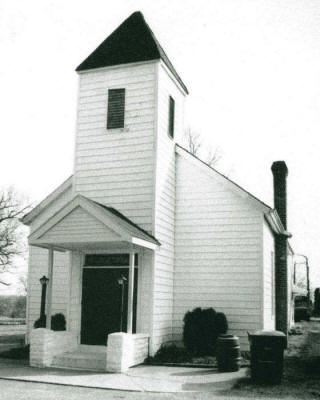The “Stumptown” Baptist Church

old photo of the First Baptist Church located on Old Floydsburg Road
—photo by Bill Lammlein
Fire ravaged it several years ago

First Baptist Church as rebuilt after the fire
Developed after the Civil War, “Stumptown” was an African American settlement centered around a log church and school paid for by the Freedman’s Bureau in 1869. Though few of its original home and stores remain, the First Pewee Valley Baptist Church, where the Little Colonel attended a Sunday service with her nurse, Mom Beck, in The Little Colonel and later, an African American wedding in The Little Colonel Maid of Honor, continues its ministry today. Sadly the early sanctuary burned in 2003 (which was located on Old Floydsburg Road west of Ash Avenue). Pewee Valley’s black school remained on church property until 1952, when a modern new facility was built at 331 Ash Avenue. That building has since been converted to a church.
Stumptown is mentioned in The Little Colonel series in several books, including The Little Colonel Maid of Honor and The Little Colonel’s Knight Comes Riding.
In Maid of Honor, it is in Chapter XIV: A Second Maid of Honor, and is where an African American wedding is held.
“…The path they followed was a wide one, and well worn by the feet of churchgoing negroes, for it was the shortest cut between the Valley and Stumptown, a little group of cabins clustered around the colored church….The bare, unpainted little church had just been lighted when they arrived….”
In the Little Colonel’s Knight Comes Riding, it is referred to in several places, including The Hanging of the Mirror, when Gay talks about being the robin who came to the rescue:
“I went over to Stumptown bright and early — you see I remembered the short cut through the woods “
(she was going to find a servant who would cook for them)
Stumptown itself is in ruins
From History & Families Oldham County, Kentucky: The First Century 1824-1924:
Pewee Valley First Baptist Church (in Stumptown)
On April 10, 1869, Henry Smith and his wife , Susan, transferred by deed slightly over one acre of land to Charles B. Cotton as trustee for the African Baptist Church. The purchase price of the lot was one hundred eight dollars. Located approximately 16 miles east of Louisville, the land was near the Pewee Valley Railway Station on the Louisville & Frankfort Railroad.
Prior to official transfer of property, the Freedman’s Bureau of Kentucky assisted former slaves with the erection of a crudely constructed building to serve as a church on Sunday and as a school during the week. Men of the congregation worked diligently to clear the wooded plot. Utilizing the felled timber, they hewed tables and pews to finish the church building.
During the formative years, the church function as a Union Church. Methodist and Baptist congregations shared the building, alternating Sundays, for their worship. After several years of the shared arrangement, the Methodists constructed a church building, now called Sycamore Chapel, for their own congregation’s benefit.
The Rev. Alexander Taylor assumed leadership of the Baptist church in 1869. The church, named Pewee Valley First Baptist Church, grew under his guidance. Because of inadequate lighting, the minister conducted one Sunday service in the early years. With the acquisition of kerosene lamps, however, evening services followed.
In July 1878, Charles B. Cotton executed a Deed of Trust to James Huffman, Thomas Davis, Anderson Hitt and Bartlett Frazier (could this be the B. Frazier for whom the other black settlement Frazier Town was named?), trustees of the church. In the late 1860s, Cotton had advanced money to trustees of the church and had executed a bond in the amount of $275 to the Freedman’s Bureau. The bond insured that the members of the church would complete the church structure. Not until February 12, 1890, did Cotton render a deed to the trustees, Frazier, Hitt and Jerry Hardin.